This article lays the groundwork before we release the practical guide and other learning material on AIO. I can’t overstate the importance of this piece and this topic. AI is revolutionizing our world faster than we can keep up with, and before we are able to fully understand, it will permeate every single facet of our lives. Digital marketing, and specifically, how patients find your practice, is no exception. Learn all you can, because this single topic will change your practice — forever.
Remember when you first saw a practice posting videos on TikTok? You probably rolled your eyes and thought, "Really? Dancing doctors? What's next?"
But then you watched their follower count explode. You saw their consultation bookings triple. Suddenly, that ‘silly little app’ didn’t look so silly anymore.
How about when Instagram Stories launched? “Great,” said your crankiest, most under-caffeinated inner voice. “Another feature to master. Another algorithm to appease.” But practices that embraced it early built deeper patient relationships and saw engagement skyrocket.
Go back further: YouTube videos. Facebook business pages. Some of you might even remember when you were ‘forced’ into getting a website. Each time, the pattern was the same: initial resistance, gradual adoption, then scrambling to catch up if you waited too long.
By a show of hands: How many times have you looked back and thought…
“If I’d just gotten in earlier…”
“If I’d just understood what this was becoming…”
Well, boys and girls, gather around, because it's happening again. This time, the stakes are higher, the timeline is shorter, and the impact is more fundamental than anything I've seen before.
Artificial intelligence is ushering in an entirely new paradigm for how patients discover, research, and choose their aesthetic providers.
And unless you’re actively shaping what AI knows about you?
You're invisible.
Google Who?
Picture this:
Jennifer — Jenny to her friends — is a mother of two, a wife, and a school teacher. She sits quietly in her living room after putting her kids to bed. The house is finally still, and for the first time all day, she has a moment to herself. There’s a lot running through her mind.
Like many moms, Jenny has been thinking about a mommy makeover for a while. Although she loves the idea of feeling more like herself again, she hasn’t booked because the options overwhelm her, the recovery feels daunting, and let’s be honest… who has the time?
She’s tired of the indecision. She’s finally ready to start figuring out her possibilities.
Two years ago, Jenny would’ve gone to Google and spent hours scanning hundreds of pages to gather the information she needed.
Tonight, she simply opens ChatGPT and begins to speak:
"Hi Abby, I'm considering a mommy makeover after having two kids. I live in Dallas and I'm nervous about the recovery time since I work full-time. Can you explain what's involved and recommend some good surgeons who understand the needs of working moms?"
(Yes, she named her AI Abby. Lots of people name their AI program. Haven’t you?)
Abby doesn’t hesitate. Doesn’t give her ten blue links and an ad for Groupon lipo. There are no ads. There is no BS. Instead, Abby gives Jenny a clear, comprehensive, personalized response in seconds:
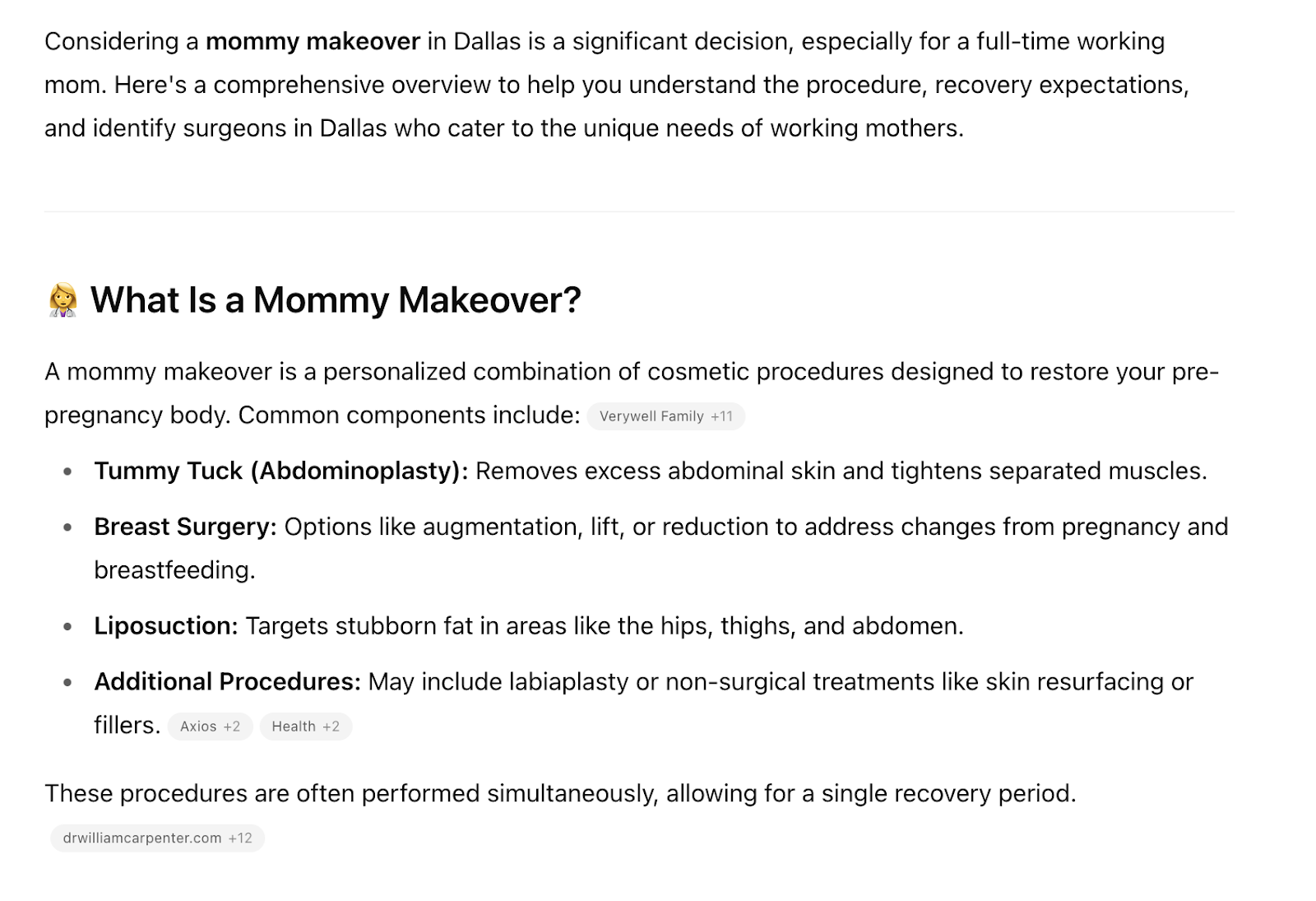
Abby doesn’t stop at basic definitions. She also discusses realistic recovery timelines for working mothers like Jenny:
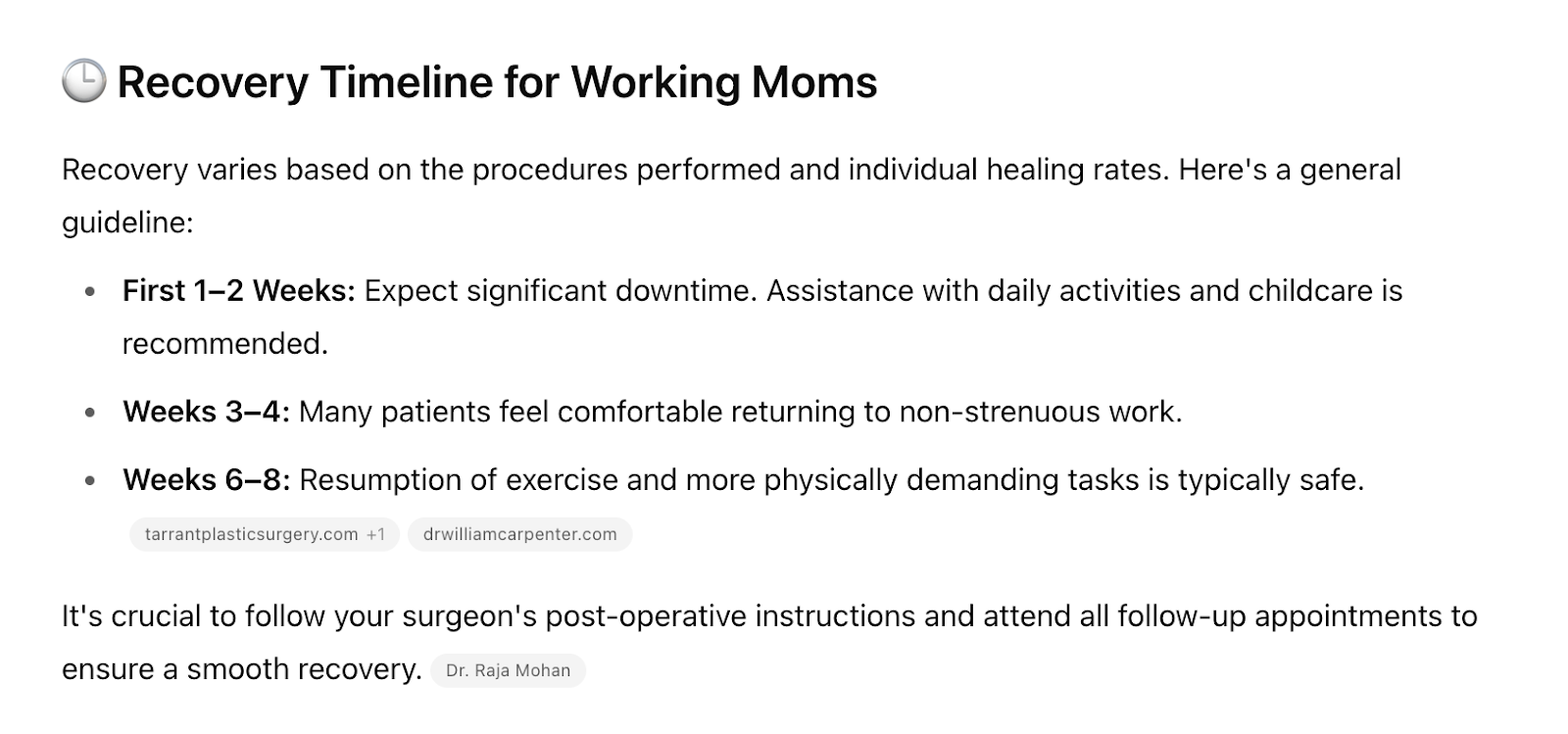
Then Abby recommends a list of board-certified plastic surgeons in Dallas based on what Abby believes is important to Jenny:
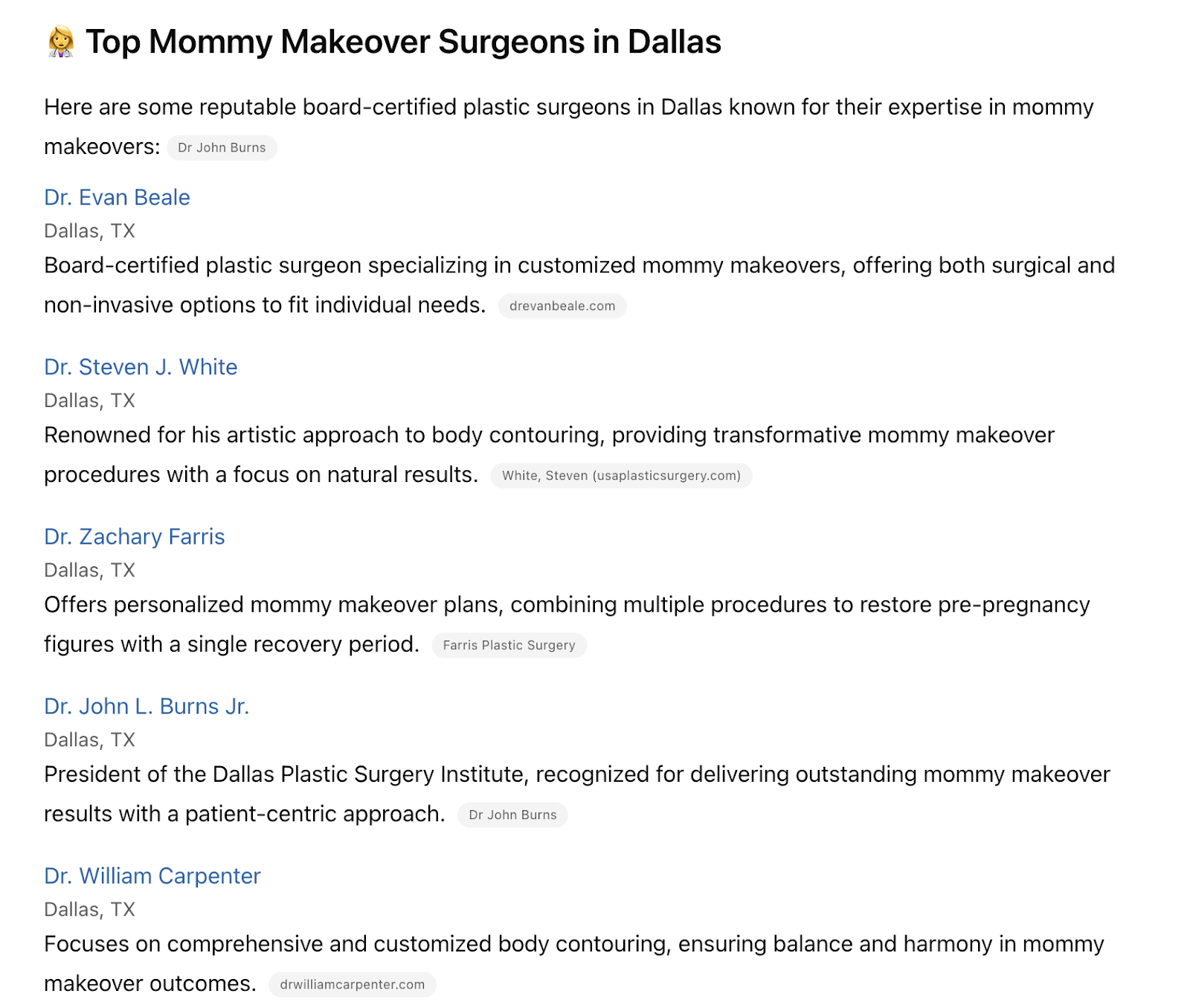
She also discusses tips for a smooth recovery:

Let’s pause here.
Did you notice what DIDN’T happen?
Jenny has yet to visit a single practice website. She never scrolled through Google’s infinite search results. She never clicked on carefully crafted pay-per-click ads, attention-grabbing SEO headlines or keyword-optimized content.
AI bypassed the entire traditional search ecosystem to give Jenny direct recommendations. Just like a trusted friend would. Jenny is now pointed in this direction, towards these doctors, without ever even asking Abby why.
And this, my friends, is just the beginning.
The Speed of Change
“Okay Sam, you’re reaching now. We’re talking about the distant future here. Flying cars and machines that make me Earl Grey tea. Hot!”
Nope. It’s happening as we speak. Just follow the data.
Unlike previous digital marketing shifts that evolved gradually over years, the AIO revolution is happening at breakneck speed. The numbers don’t lie:
- ChatGPT reached 100 million users faster than any technology in history
- Google is already integrating AI-powered answers into traditional search results
- A 2024 survey by the Aesthetic Society indicates that 83% of patients seeking cosmetic procedures researched their options online before deciding on a procedure
By conservative estimates, 30-50% of aesthetic procedure research will involve AI interactions within the next 18 months. That's not a distant future trend — it's your current patient base's evolving behavior, especially as Gen Z steps in as both the next generation of aesthetic patients and the first to trust AI more than Google.
If all that data doesn’t convince you, follow the money instead:
- Tech giants poured an unprecedented $246 billion into AI development in 2024 alone
- Microsoft has invested at least $13 billion into OpenAI since 2019, underscoring a major financial bet on generative AI
- Alphabet (Google’s parent company) reaffirmed plans to invest $75 billion in 2025, largely dedicated to servers, data centers, and networking capacity to support AI and cloud growth
…That’s not counting the wave of private equity and VC funding flooding into AI startups — a record 46.4% of the total $209 billion raised last year.
If you're still optimizing exclusively for traditional Google searches, you're setting up shop on a soon-to-be-abandoned road while the new (and extremely well-capitalized) superhighway is being built right next door.
Why AIO Matters — Especially for Aesthetics
AI is changing every industry, but that shift is showing up especially fast and hitting especially hard in aesthetic medicine.
Why?
Because this field lives at the intersection of three things AI is built to dominate.
Aesthetic Decisions Are Heavily Researched
Most patients don’t impulse-buy facelifts. Aesthetic procedures require extensive education and emotional readiness. Patients spend (or used to spend) weeks or months gathering information, reading reviews, comparing options, and building confidence in their choices.
AI takes away all the hard work.
Let’s go back to Jenny. If she’d pursued a mommy makeover back when she first thought about it, her research process would have included many steps:
- Google searches
- Reading blog posts about the procedure
- Studying RealSelf reviews
- Scrolling through patient testimonials on Instagram
- Watching filmed operations on YouTube
- Comparing surgeon credentials across multiple websites
She’d find herself in a bottomless, time-consuming rabbit hole of information, and when it all felt like too much, she might shelve the idea of surgery for another day that never came.
Now, one conversation with Abby replaces all those steps. Abby combs through everything within seconds — articles, reviews, clinical data, patient testimonials — and distills it into a single, personalized answer with links to sources where Jenny can learn more. Jenny barely has to lift a finger and all the information she needs is delivered to her digital doorstep.
If Abby includes you in that answer, you’re in the running.
If she doesn’t, you never even cross Jenny’s mind.
Aesthetic Decisions Are Deeply Personal
If aesthetic medicine were only about wrinkles and waistlines, your job would be a lot easier. But it’s not. It’s emotional. Patients come in seeking identity shifts after years of self-doubt, shame, low confidence, and other emotions they may hesitate to voice out loud, even in the safe environment of a doctor’s office.
That’s exactly why AI is having such an impact on this industry. It meets patients in their most vulnerable moments without pressure or judgment. It doesn’t make assumptions or try to upsell. There’s no clock running down on a consult. Patients can reveal their most intimate concerns, repeat themselves, compare options, express hesitation, and take all the time they need for consideration without worrying about coming off as difficult or insecure.
And now for the real revelation, Jenny trusts Abby. She doesn’t feel like she’s talking to a faceless algorithm, because AI models like Abby respond conversationally with thoughtful, considerate answers. All the data shows us that patients implicitly trust AI, and are likely to make a decision based on that trust.
But then there are the things that build trust that Google’s simple search results could never do. Abby was there for Jenny during a rough patch with her husband, recommending experts for couples therapy. She supported her with career coaching when Jenny had to make the tough decision to switch jobs. And Abby knows her skincare concerns, her past treatments, her budget, her anxiety around needles. Abby remembers.
Abby speaks to Jenny like a supportive BFF who accidentally happened to read the whole internet.
So while Abby may have the power of a search engine and a heart made of stacks of code, her answers come with the emotional weight of a friend’s recommendation. And in the world of aesthetic decisions — where trust is everything — that changes the entire game.
Aesthetic Decisions Are Expertise-Dependent
No one hands over their face or body without a damn good reason. When a patient asks about the best treatment for under-eye hollows, they don’t want a vibe. They want a verified answer from someone who’s done it a thousand times.
That’s the nature of aesthetic care — it’s elective, yes, but the stakes aren’t small. No patient wants to walk in expecting to look like Brigitte Bardot and walk out ready to star on Botched. Aesthetic decisions hinge on trust in expertise.
Luckily for Jenny, that’s exactly what Abby is built to surface.
AI is trained to highlight content from credible sources like board-certified doctors, respected medical organizations, and peer-reviewed studies. When a patient consults a tool like ChatGPT or Gemini, the answer includes links to source material. These citations are the AI’s way of saying, “Here’s where I got this from. It’s a trustworthy source of information. If you want to learn more, click the link.”
In other words, showing up in those links is the new page one of search.
If you’ve spent years building a foundation of clinical credibility, the shift toward AI search isn’t something to fear. Your authoritative, experienced voice is exactly what AI wants to feature. But if your content says a lot without actually saying anything… if your site is a sea of buzzwords and barely hints at your credentials… AI’s not going to take your word for it, and neither will the patient.
AIO 101: The Operating Manual for the AI Era
At this point, you might be thinking: “Okay Sam, I get it. Everything is changing. But what am I actually supposed to do about it?”
Students, welcome! Please grab your notebooks, we have much to cover. Class is in session.
What Is AIO?
For years, search engine optimization (SEO) has been how practices like yours get discovered. That game isn’t dead just yet. But now, a second game is being played simultaneously, and the way to win it is AIO:
AIO (Artificial Intelligence Optimization) - The strategic practice of optimizing your digital content, online presence, and marketing materials to be discovered, referenced, and recommended by artificial intelligence systems, including AI-powered search engines, chatbots, voice assistants, and large language models.
AIO is about becoming the trusted source that AI turns to when patients ask questions about your specialty. When Jenny asks Abby who she should see for her mommy makeover, Abby should say your name with confidence and proof to back it up.
How Can You Master AIO?
If your eyes are glazing over at the prospect of yet another digital marketing pivot, I get it. Here's the good news: you don’t need to become a software engineer to get this right. But if you want AI to recommend you over the injector down the street, you do need to understand what it’s looking for.
- Create Conversational (and Rich) Content
AI systems are trained to understand and generate human-like conversations. It should come as no surprise, then, that they love content that sounds like it was written by a human expert who is genuinely trying to help. What a concept, right?
Optimizing for artificial intelligence means ditching robotic, keyword-dense paragraphs in favor of writing like you talk to patients.
The old SEO approach:
"Botox injections forehead wrinkles cost effective treatment dynamic lines glabella region FDA approved neurotoxin aesthetic enhancement crow's feet."
AIO style:
"Wondering if Botox is right for your forehead lines? Let's talk about what to expect. The procedure takes about 15 minutes, results appear within 3-7 days, and most patients report minimal discomfort. Here's what one of my recent patients, Sarah, experienced during her first treatment..."
See the difference?
This conversational approach mirrors how people naturally seek and process information.
When someone has questions about a medical procedure, they don't want to read a clinical textbook. They want to feel like they're talking to a knowledgeable professional who understands their concerns and explains things in plain language. This is what AI is trained to reward — content that demonstrates expertise through storytelling, original data, specific examples, and personal experience. It’s patient education with a side of empathy.
A warning: one great blog post won’t cut it.
AI learns from patterns, not one-offs. Visibility in AI systems — real, lasting visibility — comes from volume and consistency. AI models are constantly scanning for content that’s fresh, in-depth, and helpful so it can give users the best answers. If you want to be seen, you need to be creating and regularly updating a lot (and I mean A LOT) of high-quality material.
Your goal is to turn your digital presence into a rich ecosystem of blog posts, service pages, FAQs, guides, testimonials, visuals, and more that’s simply too valuable for AI to ignore.
*Writer’s note*
Excited to produce all that amazing content with AI as we discussed in the previous part of the series? Well, I'm sorry to break it to you, but it looks like you won't be able to (at least if you just copy and paste the exact output). Hahaha. Although in the beginning we were told AI content would be viewed the same as any other content, that has been rolled back, and back, and back. Why is that?
AI knows the one thing it fails at: thought leadership. That is still the domain of us meat sacks. It's still ours because, by design, generative AI can't produce originality. It only reshapes existing content, and we're the ones feeding the machine with our very own ideas. Paradoxically, the one thing AI can’t do — true thought leadership — is exactly what it values most. It penalizes its own creations.
- Use Structured Data
I’m sure you know the jokes about doctors having indecipherable handwriting.
Well, to AI systems, most websites look like chicken scratch. If you want Abby and her friends (voice assistants, chatbots, etc.) to recommend your practice to patients like Jenny, they need to be able to read the “handwriting” your website is composed in. You achieve that using structured data (schema markup).
Schema markup is a piece of code you add to your website that provides AI models with explicit clues about the meaning of your content. Essentially, it helps them understand what your content actually means, not just what it says.
Let’s take a look at an example of a good medical schema markup, taken from https://gothamplasticsurgeryny.com/

That wall of code doesn’t need to mean much to you to see the difference when we compare it to a mediocre example:
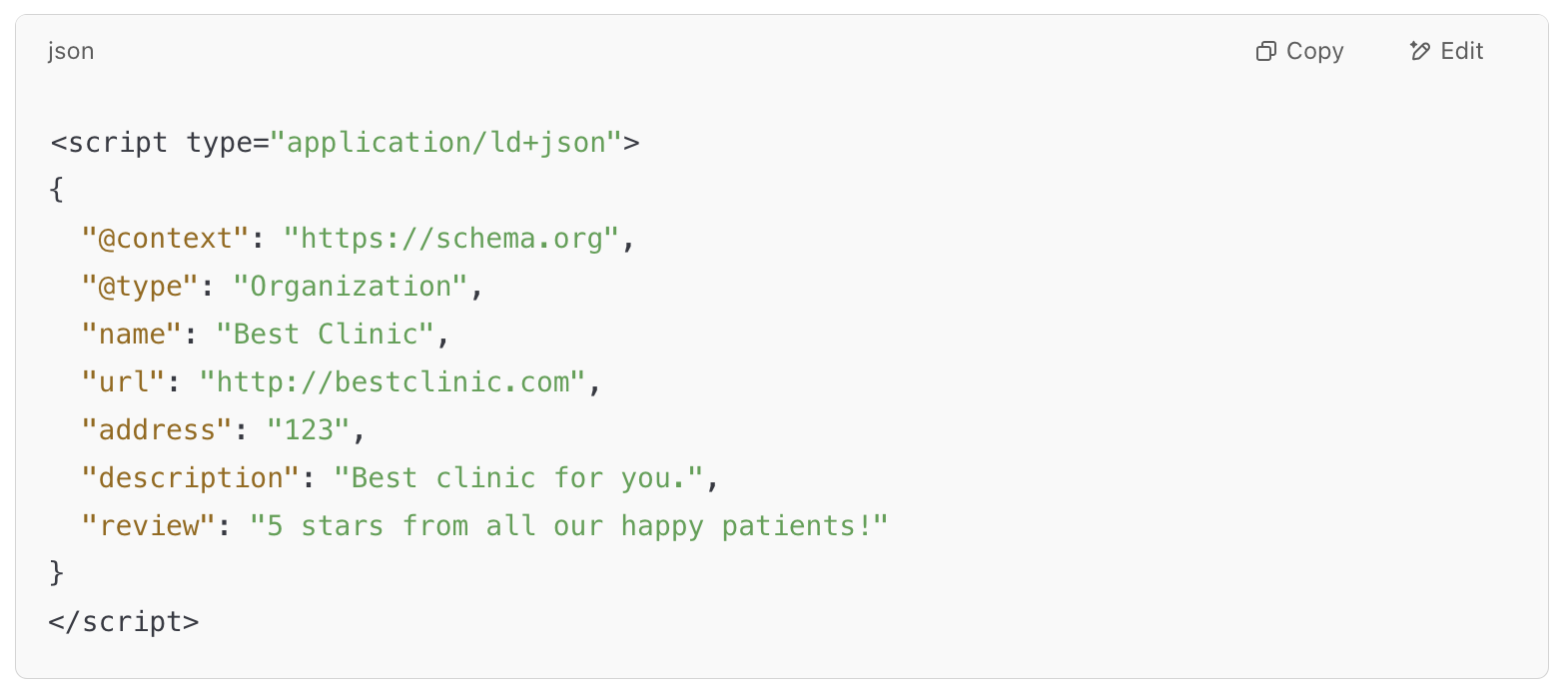
Good medical schema markup needs to be DETAILED. It should include elements such as:
- MedicalBusiness: Defines your practice's name, address, and contact information.
- Physician: Specifies details about medical professionals, including specialties and credentials.
- MedicalProcedure: Describes medical procedures offered, such as consultations or treatments.
- MedicalCondition: Provides information on conditions treated at your practice.
- MedicalSpecialty: Indicates the specific medical specialties your practice covers.
- FAQPage: Lists frequently asked questions and their answers, enhancing user experience.
- Review: Showcases patient reviews and ratings to build trust and credibility.
- ImageObject: Tags images, such as before-and-after photos, with relevant metadata.
- It can even contain links to your social media, your telephone number, or precise hours of operation.
All of these categories answer the most important questions for both AI models and potential patients:
- Who are you?
- What do you do?
- Where do you do it?
- Why do people trust you?
Bad schema markup, on the other hand, is vague, simplistic, or just plain wrong. It’s like handing someone a business card with half the info missing.
Imagine a clinic using schema that only says:
“Organization. Name: Best Clinic. Address: 123. Review: 5 stars!”
That’s not useful. There’s no real address, no structured review format, and nothing that tells AI what kind of services you offer or who’s behind them. Instead, you have to dive into specifics:
“This is a MedicalClinic that specializes in PlasticSurgery, located at 123 Main Street in Dallas, Texas. It’s run by Dr. Jane Smith, a board-certified plastic surgeon, and here’s a 5-star review from a real patient who had a mommy makeover.”
When an AI is deciding which website to show to someone asking "Who's the best plastic surgeon near me?", it's going to pick the result that actually answers that question.
If you won't talk to the robots in robot language, they're simply not going to listen. And more importantly, they won’t recommend you, even to patients who are looking for exactly what you do.
- Demonstrate Genuine Authority
One of the biggest differences between SEO and AIO is how each defines and measures digital authority.
According to the longstanding SEO rules, authority is akin to a popularity contest — whoever has the most impressive number of credible backlinks wins. But Abby knows that links don’t maketh the surgeon.
She cares whether you actually know what you're talking about.
The New AIO Rules of EEAT
Google (and we) have been talking about EEAT for years. It stands for Experience, Expertise, Authoritativeness, and Trustworthiness, and it’s the framework Google uses to evaluate content quality. These four signals help the search engine determine which sources deserve to be surfaced in results.
EEAT still matters. But here’s what’s new: AI systems are redefining how those signals are interpreted and raising the bar for what it takes to be considered a credible source.
Let me break down what this looks like in practice:
Experience in the AIO era means sharing insights that only someone who's actually done the work would know about. It's the difference between reading about riding a bike and having the scraped knees to prove you've fallen off one. Want to prove your experience to AI? Include case studies, before-and-after galleries with captions, and firsthand observations in blog posts and videos.
Expertise is all about subject-matter knowledge and professional qualifications, like board certification, years of experience, published articles, peer-reviewed research, or speaking engagements. Even a well-written FAQ page can help establish you as someone who actually knows what they’re doing.
Authoritativeness is earned through external validation. That means mentions on credible medical sites, strong reviews on Google or RealSelf, interviews on podcasts, affiliations with respected clinics, and being quoted by the media. AI models connect these dots to understand who holds weight in a particular field.
Trustworthiness comes from transparency and consistency. AI notices if your clinic’s name, phone number, credentials, and services are consistent across platforms. It favors websites with HTTPS, real addresses, clear privacy policies, patient safety info, and content that doesn’t make exaggerated claims.
Traditional SEO EEAT tells search engines whether your website is credible through backlinks, page structure, and web hygiene. In an AIO world, the scope is bigger. AIO EEAT shows AI systems that you’re a trusted source of information across every channel, not just on your website. That means demonstrating knowledge, transparency, and originality anywhere your name appears online.
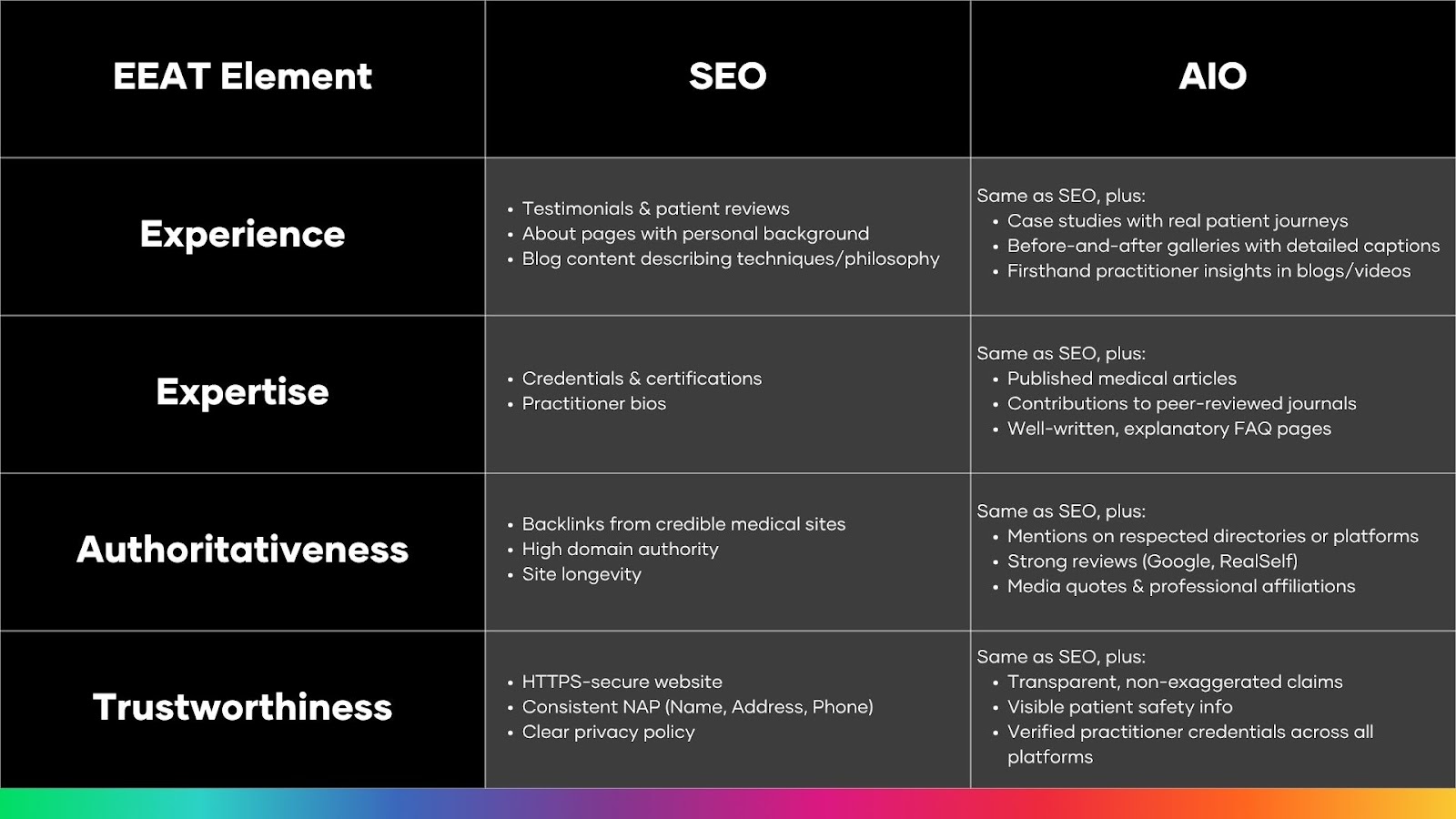
But what does EEAT-compliant content looks like in AIO?
"In my fifteen years of practice, I've observed that patients who achieve the most natural-looking breast augmentation results typically choose implants that increase their size by 1-2 cup sizes. Here's why:…"
"I've started using a modified suturing technique I learned at the American Society meeting last month that reduces scarring by about 30% in my patients. The key is adjusting the…"
"Last week, a 28-year-old patient came in requesting a dramatic rhinoplasty to completely change her nose shape. After our consultation and computer imaging session, I recommended a much more conservative approach. Here's why: her current nose…"
See what I mean?
These examples are personal, grounded in real clinical experience, and specific enough that AI can recognize the content as authentic and trustworthy. These aren’t generic ctrl + C, ctrl + V tips. They sound like a doctor actually talking to a patient, which is exactly the kind of content AI models like Abby prefer.
Measuring AIO Success
Traditional SEO metrics (keyword rankings, organic traffic) remain important but don't tell the complete AIO story. Nowadays, to track your digital success, you need to play detective. Here are two key ways to measure your AIO performance:
- Monitor AI Recommendations
First, you need to know if AI systems are mentioning you. This means regularly testing queries your patients would ask and seeing which names come up. Try asking ChatGPT questions like:
- "Who's the best plastic surgeon for breast reconstruction in my area?"
- "What should I know before getting a tummy tuck?"
- "Which clinic has the best reviews for rhinoplasty in my city?"
If your name isn't appearing in responses related to your specialties, if your website isn’t being cited as an authoritative source, you've got some work to do.
The same goes for mentions in voice search results. Except now, the goal is not just to show up in tools like Google Assistant or Siri, but also when patients are chatting with AI assistants like ChatGPT, and that’s a whole new sandbox to play in.
ChatGPT isn’t just a “middleman” pulling from Google — it’s its own universe. It learns and evolves from the information it gathers, offering conversational answers based on its training and real-time context.
When your practice is mentioned in responses generated by ChatGPT, it signals something powerful: AI considers you a relevant, trusted source. If you’re not in the AI conversation, you’re not in the patient’s consideration.
Your Agency should help you monitor your “reference score” and when and how you are mentioned, just like a standard SEO keyword / Key Phrase tracker. If you do not have an agency, you can use a tool like SEMRush, or give me a call, I’ll be your wingman.
- Monitor Lead Sources
While still in its early stages, it’s now possible to track whether AI models like ChatGPT are referring users to your site. Expect this to become a key metric of AIO success in the near future.
Currently, the process is mostly manual. Marketers and developers can look for patterns in website traffic or use special tracking links to spot when someone arrived through an AI-generated recommendation.
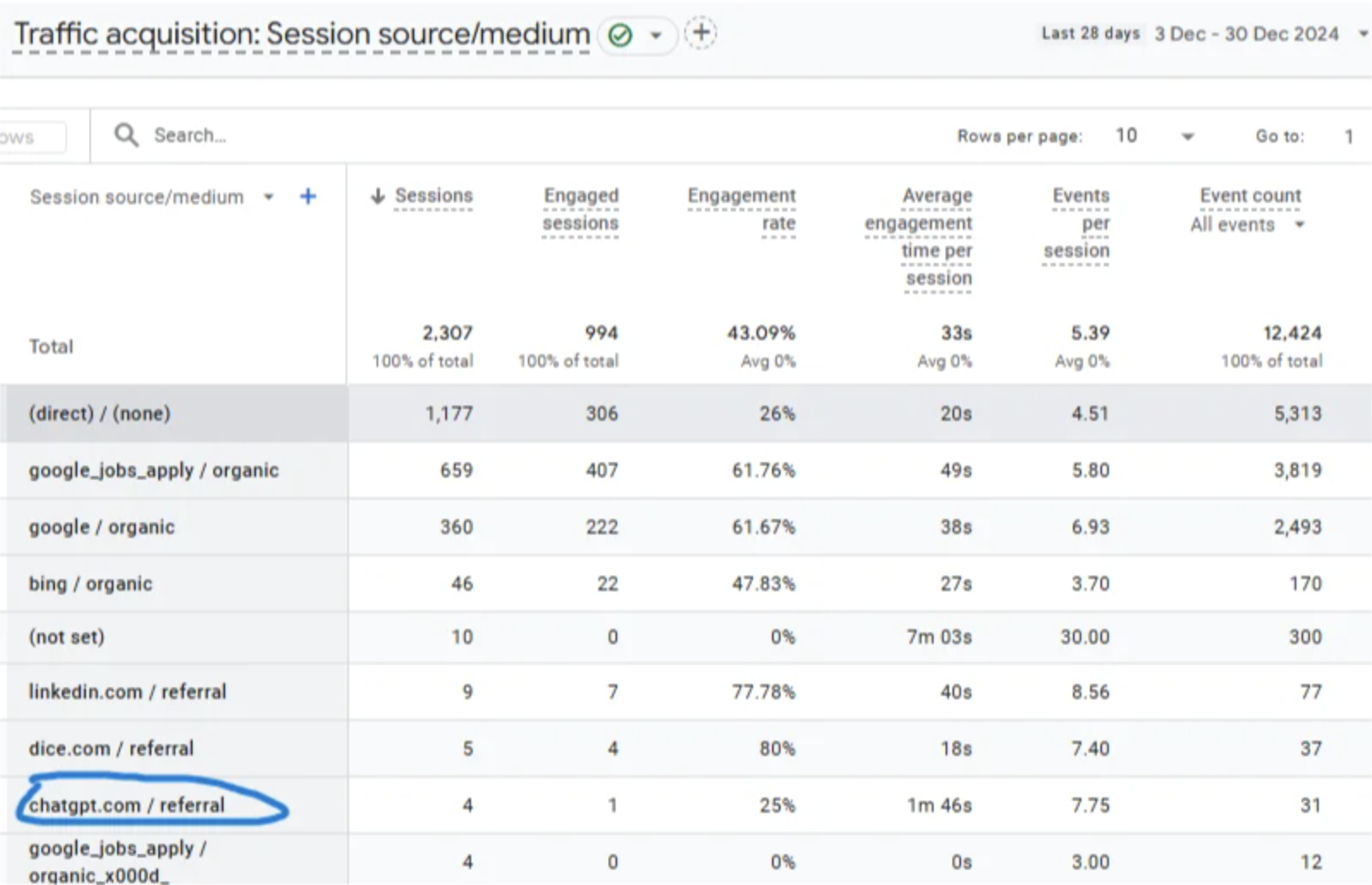
And while analytics platforms don’t yet offer systems for tracking “ChatGPT traffic,” the infrastructure is coming. Just as SEO tools evolved to track keyword rankings, new tools will emerge to help:
- Tag traffic from AI interfaces
- Filter traffic by referral source or AI identity
- Quantify how many users AI models are sending to your site
- Compare AI-originated traffic to traditional SEO traffic
The bottom line? If you can see AI models referring more and more users to your site, and you're consistently spotting your name in AI-powered search results, congratulations — you're future-proofing your practice’s online visibility.
I Really Don’t Think This Applies to Me…
Let me stop you right there.
I get the hesitation. You've seen trends come and go. You’re wary of investing time in a fad that will quickly fade or a tactic that will become obsolete faster than Quibi. You’re already inundated with pitches about magical marketing tricks and "game-changing" technologies using “the latest and greatest AI” that mostly just change your bank account balance (and not in a good way).
Here's the thing, though: I'm not here with my hand out. I'm not about to pitch you some expensive course or consultation package. I don't have a special AI optimization tool to sell you or a monthly service to sign you up for. (Well, not yet… ;-))
I'm sharing this because I genuinely believe we're at one of those inflection points in healthcare marketing that happens maybe once a LIFETIME.
If you're sitting there thinking this doesn't apply to your practice, or that it's just another marketing fad that'll blow over, you’re simply wrong. Every major indicator is pointing toward a permanent shift in how trust and visibility work online.
Get me a show on the Discovery Channel, because I'm about to bust some myths.
- "My patients still use Google for research."
You're absolutely right — they do. In fact, at the moment, exactly 89.5% of people still do.
But Google is integrating its AI model Gemini into search. I mean, have you googled anything lately? Have you noticed the AI-powered answers? Those featured snippets at the top of search results? It sees the future. Why would you bet against Google?
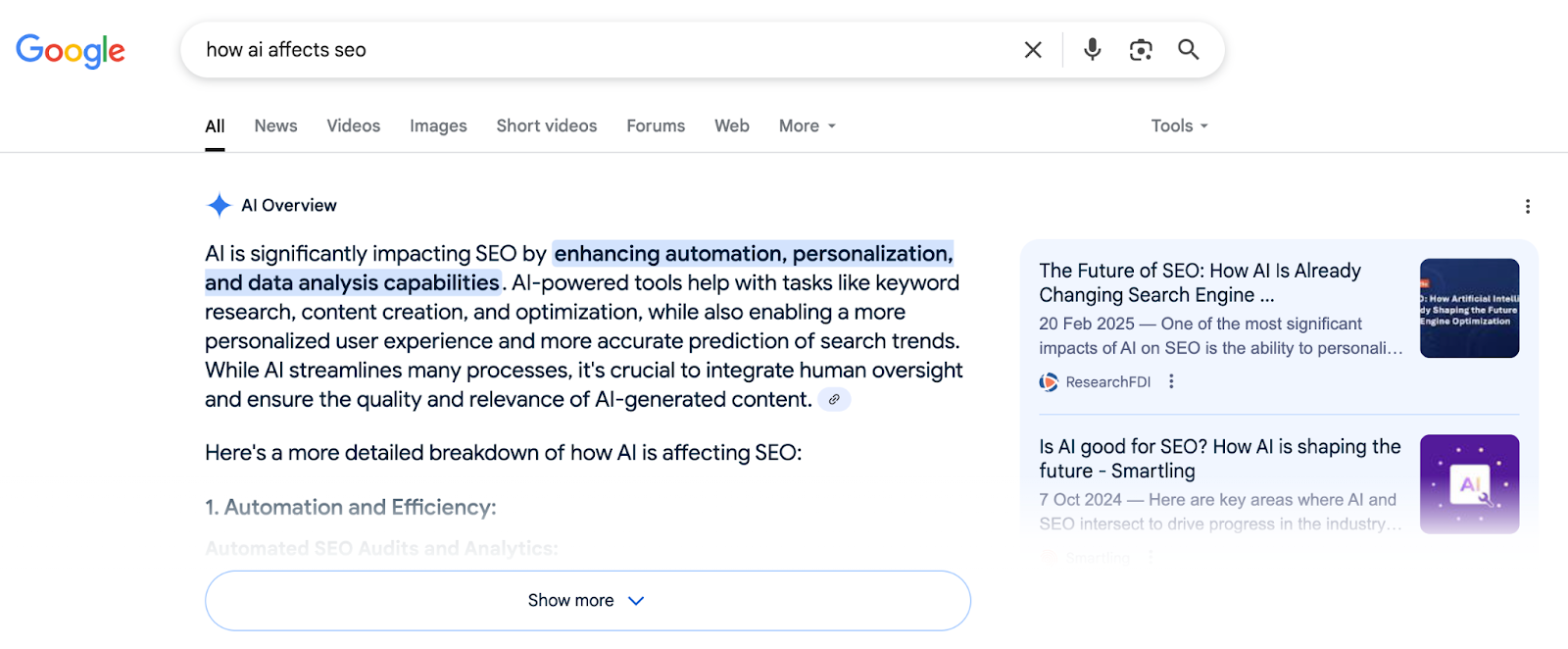
Those "People also ask" sections?
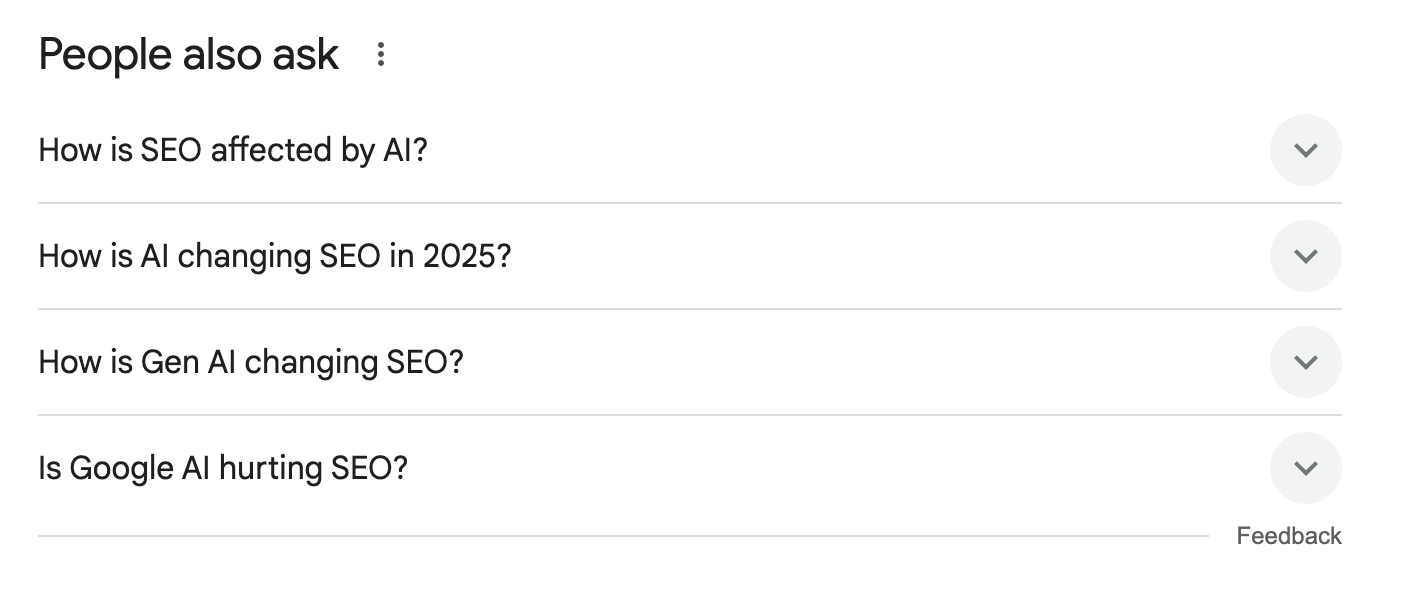
Also AI-generated. The local business recommendations that pop up when someone searches for a plastic surgeon?
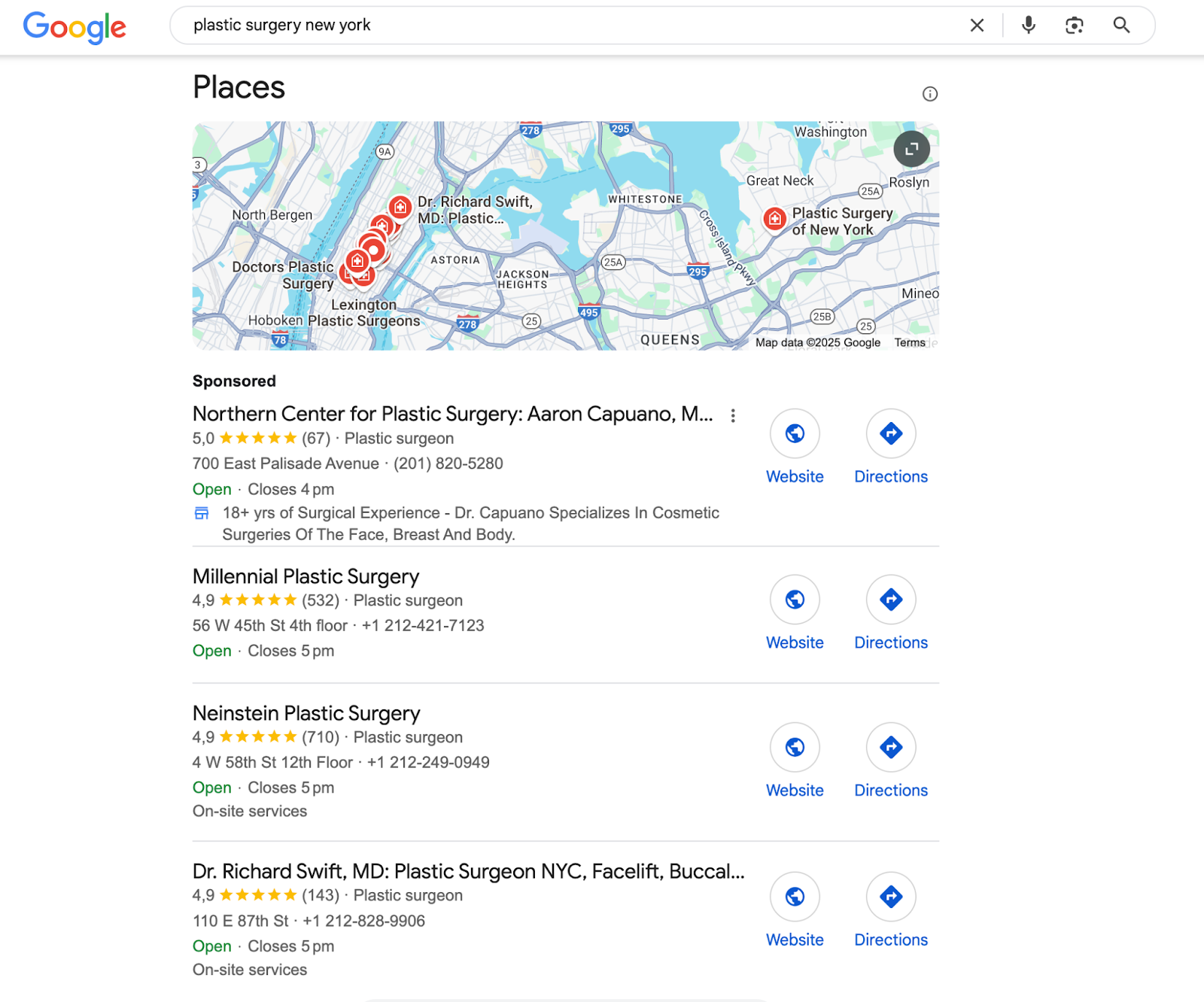
You guessed it — AI is heavily involved in those, too.
Even if your patients never touch ChatGPT or ask Siri a question, they're already interacting with AI-powered search results every single day. We’re standing at the edge of a massive, irreversible change in how search functions for everyone. That’s why AIO applies to your practice.
- "This seems like another marketing fad."
You could have said the same thing about electronic health records back in 2005. And telemedicine in 2015. And patient portals. And online reviews. Funny how all those "fads" became absolutely essential to running a modern practice, isn't it?
AI adoption in healthcare is following the same trajectory. First, the early adopters get an advantage. Then it becomes standard practice. Finally, it becomes so fundamental that practices without it start looking outdated.
We're currently somewhere in stage one, and you might think you have time to catch up, but AI is growing at a faster pace than anything we have seen before. It’s a drag race, and the light just turned green.
The difference is, this time you have advance warning. You can get ahead of the curve instead of scrambling to catch up when every other practice in the city is suddenly showing up in AI recommendations and you're not.
- "My practice is doing great, I don’t need more patients"
Okay big shot, I believe you. But it doesn’t matter if you're booked solid for the next six months. Patient research behaviors are evolving whether you participate or not.
The question isn't whether you need new patients — it's whether you want to maintain visibility as the landscape changes around you.
Here's something you might not have considered: your referral sources are changing, too. That dermatologist who sends you patients? She might start asking AI which plastic surgeons she should recommend for specific procedures. The primary care doctors in your network? They're also increasingly using AI tools to research specialists for their patients.
Look, I’m not here to freak you out. I just want you to consider this: what’s the cost of being wrong?
If AI doesn’t shake up medical marketing like I say, no big deal — you’ll just end up with better content and clearer messaging on your site, which is always a win.
But if AI really is reshaping how patients research and how referrals are made, then ignoring it isn’t just risky. It’s reckless. You build visibility now or you lose it by default.
Adapt or Disappear
AIO is a fundamental shift in how patients find and choose their healthcare providers.
The good news? This transition rewards exactly what aesthetic medicine practices should prioritize in the first place:
- deep expertise
- accurate patient education
- authentic communication
Those who have built their reputations on clinical excellence and patient care are uniquely positioned to thrive in the AIO era. For those relying solely on marketing tricks, it may be a slow and painful descent into digital anonymity.
The question isn't whether you should adapt — it's whether you'll do it while you still have the chance to establish yourself as a leader in the AIO era, or whether you'll play catch-up after watching your visibility (and new patient numbers) fade away.
Now is the time to build a reputation the future can recognize.
Abby and her friends are already here. They hold the keys to accessing Jenny and all the patients like her that your practice needs to survive. And as of today, Abby has no idea that you exist.
What are you going to do about it?
Too Long? Here's the Short Version
We're witnessing the rise of a completely new paradigm in search: AIO (Artificial Intelligence Optimization). Instead of Googling, patients now ask AI assistants like ChatGPT for personalized recommendations and answers. This isn't evolution—it's revolution happening at lightning speed. To embrace AIO, you need to create rich, conversational content, use detailed schema markup so AI can read your site, and establish genuine authority. Early adopters will dominate AI-driven search results; those clinging to outdated SEO strategies will slowly become invisible in the digital world.
We're witnessing the rise of a completely new paradigm in search: AIO (Artificial Intelligence Optimization). Instead of Googling, patients now ask AI assistants like ChatGPT for personalized recommendations and answers. This isn't evolution—it's revolution happening at lightning speed. To embrace AIO, you need to create rich, conversational content, use detailed schema markup so AI can read your site, and establish genuine authority. Early adopters will dominate AI-driven search results; those clinging to outdated SEO strategies will slowly become invisible in the digital world.











